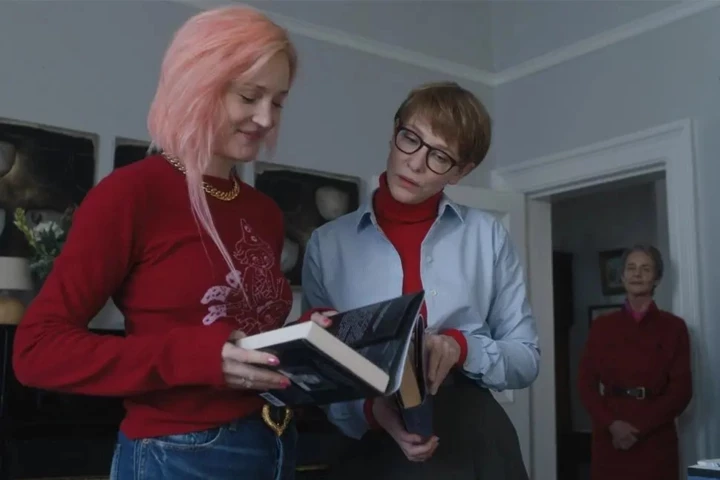
Save this storySave this storySave this storySave this story
The current Internet landscape sometimes feels like the Zone in Andrei Tarkovsky’s film “Stalker”: directionless, inexplicable, bound to change in confusing ways. Our social-media feeds don’t offer much except the forward acceleration of algorithmic recommendations. Google and other forms of search are becoming clogged with content generated by artificial intelligence. Knowing what you’re looking for doesn’t always help you chart a path, because niche communities can be difficult to locate and to keep up with. We are in a transitional phase of digital culture, and thus more in need than ever of friendly faces, personable human guides (not unlike a “stalker” in the Zone), to help us navigate this treacherous ground. Such guides go by many names—call them influencers, or content creators, or just “this one guy I follow.” Guided by their own cultivated sense of taste, they bring their audiences news and insights in a particular cultural area, whether it’s fashion, books, music, food, or film.
Perhaps the best way to think of these guides is as curators; like a museum curator pulling works together for an exhibition, they organize the avalanche of online content into something coherent and comprehensible, restoring missing context and building narratives. They highlight valuable things that we less-expert Internet surfers are likely to miss. Andrea Hernández, the proprietor of Snaxshot, a newsletter and social-media account dedicated to “curating the food and beverage space,” told me recently, “Curation is about being able to filter the noise.” (I follow Hernández for her skill at discovering the wildest examples of direct-to-consumer drinks startups, such as Feisty, a purveyor of “protein soda.”) She continued, “I go out and I scour through the Internet and I come to you with my offerings.” Unlike a museum curator, however, the digital personalities I have taken to following also become the faces of their work, broadcasting recordings of themselves, on TikTok and Instagram, as a way of building a trusting relationship with their followers.
One such curator is Derrick Gee, a former online radio d.j. who lives in Australia. I first encountered Gee on TikTok and was pulled in by his architect-ish look: thin wireframe glasses and stylishly baggy, often monochrome outfits. He records videos of himself talking into a microphone in a low, soothing voice, breaking down trends in contemporary pop music and reviewing high-end audio equipment. Gee has become a fixture of my feed; I am one of his more than three hundred thousand followers. He has introduced me to the world of Korean alt-rap, provided a playlist of ear-tickling minimalist piano instrumentals, and explained why Mitski’s latest album feels so vintage (because of an effect called “slap-back echo”). I trust him not only to show me something cool but to teach me something new. “I’m connecting the dots between cultures and sounds and eras,” he told me. When Gee was a teen-ager, his electric-bass teacher played a similar role for him when he exposed Gee to James Jamerson, the Motown bass player who put jazz runs into pop songs. “That opened my whole world up,” Gee said.
Gee’s practiced demeanor on the mike comes from his career off of social media. He began working in graphic design and then in television development, but he also pursued an interest in music with a self-recorded radio show, which he began uploading to the Web site Mixcloud in 2012. That show evolved into jobs with the music label 88rising, SiriusXM, and Mixcloud itself. Gee began posting on TikTok in early 2022, after being introduced to the platform by a successful influencer who was trying to break into music. Gee began with videos documenting his speaker collection but quickly moved on to leveraging his music expertise. He told me that he is still a d.j., of a sort: “What I do is radio but with a camera on. It’s just a break between songs,” he said. By working outside of music-world institutions, he hopes to play a small part in moving the industry forward, pushing for more informed consumption. He described himself as a kind of elder-brother figure to his audience: “If I can turn you, a seventeen-year-old Korean American, on to U.K. garage, I’ve done my job.” (For anyone who doesn’t follow Gee, “U.K. garage” is not garage rock but an influential British genre of electronic dance music that originated in the nineties and has made an impact on contemporary K-pop.)
Digital platforms are largely devoted to making users consume more, faster—think of TikTok’s frenetic “For You” feed or Spotify’s automated playlists. Curators slow down the unending scroll and provide their followers with a way of savoring culture, rather than just inhaling it, developing a sense of appreciation. Laura Reilly, who lives in Brooklyn, runs a newsletter and an Instagram account called Magasin (the French word for “store”), which she launched in 2021. Now with more than twenty-eight thousand subscribers, Magasin touts itself with the tagline “It’s a store. It’s a magazine. (It’s a fashion shopping newsletter.)” But it goes beyond simple recommendations, championing lesser-known brands—the provider of earthy, upscale basics Studio Nicholson; the knitwear maker Lauren Manoogian—and often interrogating the act of shopping itself. “The more you learn about a brand,” Reilly told me, “the longer you’re going to hold on to those pieces.” In other words, her informative posts are an antidote to fast fashion. Reilly now employs a news editor and a menswear columnist, but she serves as a writer, editor, photographer, and model. Magasin’s Instagram account features photo carrousels of her wearing outfits from the brands that the newsletter covers, but they are often dressing-room-mirror selfies, rather than polished portraits. This goes beyond convenience into an intentional business strategy: like influencing, curating online can be a parasocial act. “In order to be competitive, I needed to inject more of myself and my image into the newsletter,” she said.
Curation takes work, and like any other kind of labor it is only sustainable if it’s reasonably compensated. Gee monetizes his account by creating sponsored content on TikTok, primarily for audio-equipment brands. Magasin earns the majority of its revenue from affiliate marketing—for every reader who clicks a link to, say, a new Proenza Schouler cashmere sweater, and buys one, Reilly earns a commission based on a small percentage of the sale price. Before Magasin, Reilly worked in e-commerce fashion writing at the magazine InStyle, highlighting new product releases and deals. That approach provided inspiration for her newsletter, and set her apart from other solo fashion commentators: “I didn’t want it to be something that was a diary; I wanted it to be a service,” she said.
In a previous era of the Internet, we might have thought of figures like these simply as influencers, whose ability to attract large followings online gives them a power that sometimes surpasses that of traditional publications. But the idea of an influencer has, as Reilly put it, become “a little flattened over time,” connoting shallow, uninformed, even misleading content dictated by sponsors. “There’s a distinction between influencing and what I do,” Reilly insisted. The archetypal influencer produces life-style porn of one form or another, playing up the aspirational glamour of their own home or meals or vacations. The new wave of curators is more outward-looking, borrowing from the influencer’s playbook and piggybacking on social media’s intimate interaction with followers in order to address a body of culture beyond themselves.
Nathan Shuherk, an online curator of literature living in Indianapolis, didn’t mind the comparison between what he does and influencerdom. Given “how much of culture is filtered through the eyes of influencers,” he told me, we ought to take the job seriously. On TikTok, under the username @schizophrenicreads, Shuherk posts videos in which he delivers enthusiastic monologues about nonfiction books that reflect his personal preference for leftist, revisionist, socially engaged works of history—“How to Hide an Empire,” by Daniel Immerwahr; “Midwest Futures,” by Phil Christman. He began posting on TikTok, in 2021, as a way to pass on recommendations for articles and books to his friends; he has now amassed nearly a hundred and eighty thousand followers. Prior to running @schizophrenicreads, Shuherk had accumulated experience in a very different kind of public speaking. He has schizophrenia, and in 2017 dropped out of a master’s program in library science and went on disability leave from work to adapt to living with the illness. He occupied himself by giving lectures about his experiences for advocacy organizations. His account name was partly a reference to his illness and partly a joke about his wide-ranging taste in reading. “I never really conceived of doing this for a mass audience; I was trying to be my friends’ unemployed librarian,” he said. Owing to the cutoffs for receiving disability benefits, Shuherk tries to limit his income, but he maintains a small Patreon account, where fans can donate money and get access to extra material, including a podcast. (Full disclosure: I appeared on one episode.)
Shuherk cast the rise of curatorial accounts like his as a failure of the legacy-media ecosystem. The job of providing well-informed recommendations once belonged to professional critics employed by newspapers and magazines. As media companies have struggled to adjust to the digital age, the number of full-time criticism jobs has dwindled, leaving a void that Shuherk and others are filling. We sometimes blame the figure of the influencer for these changes. “One hundred per cent, that’s wrong,” Shuherk told me. Internet users still desire guidance from voices with expertise; it’s just that those experts, lacking other options, are increasingly finding their audiences online. “My option for becoming a book reviewer was sitting down on TikTok,” Shuherk said. “There isn’t really a path for me outside of this.”
The onslaught of online content requires filtering, whether technological or human, and those of us who dislike the idea of A.I. or algorithms doing the filtering for us might think more about how we support the online personalities who do the job well. Structurally, the Internet is not getting better anytime soon; I have not hidden my pessimism about its future. But human creativity persists, even in hostile conditions. Figures like Gee, Reilly, and Shuherk make me hopeful that fun, interesting niches of activity can still survive online. There’s another word that we might apply to such people: “connoisseurs,” in the art-historical sense of passionate observers who shape a discipline through their judgments. We’ve always had connoisseurs, from the radio d.j. to the bookstore clerk, subtly but vitally informing the culture that the rest of us choose to consume. As Shuherk put it, “The person in the nineties working at Blockbuster—we’re the same person.” ♦
Sourse: newyorker.com







